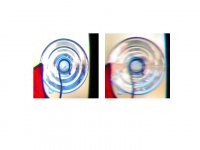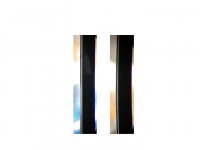henry link
Well-known member
Yesterday I was able to spend about an hour with the new Swarovski 8.5x42 EL and at least briefly compare it to a Zeiss 8x42 FL, Nikon 8x42 EDG and Leica 8x42 Ultravid (non-HD).
It doesn't take an hour to discover that the optical performance of the new EL is excellent in every category, especially the area of off-axis sharpness where it sets a new standard for binoculars in my experience. The edge of the field really is just about as sharp as the center, something I have only seen once before, in the Nikon 7x50 Prostar, but that binocular has a much narrower apparent field than the EL.
However, when an object is placed at the edge of the field in the new EL it does not look precisely like it does at the center for two reasons. One is lateral chromatic aberration, which is quite obvious toward the field edge, just as it is in other binoculars. In fact, it may actually look more striking in the EL because of the startling edge sharpness. In other binoculars the fringe of out of focus color tends to mingle with the general fuzziness at the edge, but in the EL it stands out in obvious contrast to the sharp edges of objects. Secondly, the shape of objects toward the edge is distorted. Ironically that's because of the lack of pincushion distortion that allows lines to remain almost perfectly straight across the entire field. When it comes to distortion you simply have to choose your poison. Applying pincushion distortion will largely maintain the shape of non-linear objects near the edge, but at the same time cause lines to bend. Zero pincushion distortion keeps the lines straight but unavoidably introduces angular magnification distortion which foreshortens the shape of objects toward the edge and leads to the "rolling globe" effect when panning as objects appear to be moving around the edge of a sphere as they approach the edge of the field. Zeiss and Leica use enough pincushion to maintain relatively undistorted shapes toward the edge, but lines are obviously curved. The new EL has virtually no pincushion and the Nikon EDG splits the difference with a small amount of pincushion, not enough to completely avoid angular magnification distortion but arguably enough to avoid a strong "rolling globe" for most people.
I tried an experiment in the store to see if I could photograph these distortion characteristics. I used a circular suction cup on the store window to show the distortion of a shape at the edge of the field and the straight lines of the window frame to show pincushion distortion. I just held the camera at an angle to the binocular eyepieces and photographed the field edges. The photos below show the field edge at 3 o'clock of the new EL on the left and a Leica 8x42 Ultravid on the right. I think it's clear that the EL squashes the shape of the circle but maintains nearly straight lines while the Leica maintains the shape of the circle (actually slightly overcompensates) but curves the lines of the window frame. The difference in sharpness in the photos actually looks similar to what the eye sees, but I would not depend on this method to always give an accurate impression of the sharpness the eye would experience at the edge.
It doesn't take an hour to discover that the optical performance of the new EL is excellent in every category, especially the area of off-axis sharpness where it sets a new standard for binoculars in my experience. The edge of the field really is just about as sharp as the center, something I have only seen once before, in the Nikon 7x50 Prostar, but that binocular has a much narrower apparent field than the EL.
However, when an object is placed at the edge of the field in the new EL it does not look precisely like it does at the center for two reasons. One is lateral chromatic aberration, which is quite obvious toward the field edge, just as it is in other binoculars. In fact, it may actually look more striking in the EL because of the startling edge sharpness. In other binoculars the fringe of out of focus color tends to mingle with the general fuzziness at the edge, but in the EL it stands out in obvious contrast to the sharp edges of objects. Secondly, the shape of objects toward the edge is distorted. Ironically that's because of the lack of pincushion distortion that allows lines to remain almost perfectly straight across the entire field. When it comes to distortion you simply have to choose your poison. Applying pincushion distortion will largely maintain the shape of non-linear objects near the edge, but at the same time cause lines to bend. Zero pincushion distortion keeps the lines straight but unavoidably introduces angular magnification distortion which foreshortens the shape of objects toward the edge and leads to the "rolling globe" effect when panning as objects appear to be moving around the edge of a sphere as they approach the edge of the field. Zeiss and Leica use enough pincushion to maintain relatively undistorted shapes toward the edge, but lines are obviously curved. The new EL has virtually no pincushion and the Nikon EDG splits the difference with a small amount of pincushion, not enough to completely avoid angular magnification distortion but arguably enough to avoid a strong "rolling globe" for most people.
I tried an experiment in the store to see if I could photograph these distortion characteristics. I used a circular suction cup on the store window to show the distortion of a shape at the edge of the field and the straight lines of the window frame to show pincushion distortion. I just held the camera at an angle to the binocular eyepieces and photographed the field edges. The photos below show the field edge at 3 o'clock of the new EL on the left and a Leica 8x42 Ultravid on the right. I think it's clear that the EL squashes the shape of the circle but maintains nearly straight lines while the Leica maintains the shape of the circle (actually slightly overcompensates) but curves the lines of the window frame. The difference in sharpness in the photos actually looks similar to what the eye sees, but I would not depend on this method to always give an accurate impression of the sharpness the eye would experience at the edge.
Attachments
Last edited:








